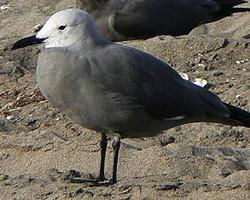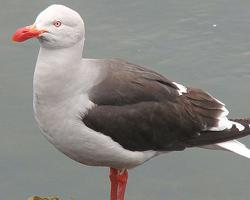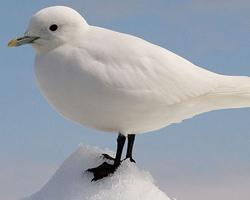
Stav ohrožení
| Ohrožen |
Popis zvířete
The Grey Gull (Leucophaeus modestus), also known as the Grey-hooded Gull, is a medium-sized seabird belonging to the family Laridae, which includes other gulls, terns, and skimmers. This species is native to the Pacific coast of South America, ranging from northern Peru to southern Chile, and is particularly associated with the cool, nutrient-rich waters of the Humboldt Current.Adult Grey Gulls exhibit a distinctive plumage that sets them apart from other gull species. During the breeding season, they boast a soft grey hood that contrasts with their white underparts. Their upper wings and back are a light grey, while the wingtips are darker with white spots known as mirrors. Outside the breeding season, the hood fades and the head becomes streaked with grey and white, making them appear less conspicuous. Their bill is a strong, medium length, and typically yellowish with a darker tip, while their legs are a greenish-yellow, adding to their unique color palette.
One of the most interesting aspects of the Grey Gull is its atypical breeding behavior. Unlike many other gulls that nest in large colonies on coastal cliffs or islands, Grey Gulls often nest solitarily or in small groups in the extremely arid Atacama Desert, some distance from the sea. This unusual choice of nesting site is thought to be a strategy to avoid predators, and the gulls commute daily to the ocean to feed.
The diet of the Grey Gull primarily consists of small fish, crustaceans, and marine invertebrates, which they obtain by surface dipping or shallow plunging. They are also known to scavenge and may follow fishing boats for offal or discarded catches. During the breeding season, they may also consume insects and other small prey found in the desert.
Grey Gulls are social birds outside the breeding season and can often be seen in flocks, particularly during migration or when roosting. Their calls are typical of gulls, consisting of a range of squawks and mewing sounds that serve as communication among individuals.
Conservation-wise, the Grey Gull is currently classified as Least Concern by the International Union for Conservation of Nature (IUCN). Although the population trend is not well known, the species is not believed to be experiencing significant declines. However, like all wildlife, they face threats from habitat loss, pollution, and human disturbance, and monitoring is necessary to ensure their continued health and abundance.
In summary, the Grey Gull is a unique seabird with an atypical desert nesting habit and a distinctive appearance that sets it apart from its coastal cousins. Its life along the Pacific shores of South America is finely tuned to the rhythm of the sea and the harsh desert, exemplifying the remarkable adaptability of gulls as a group.
Podobná zvířata
Nové fotografie zvířat
Top 10 zvířat
- Common cockchafer (Melolontha melolontha)
- Common house mosquito (Culex pipiens)
- Colossal squid (Mesonychoteuthis hamiltoni)
- Giant house spider (Eratigena atrica)
- Harpy eagle (Harpia harpyja)
- Fruit fly (Drosophila melanogaster)
- Common reed warbler (Acrocephalus scirpaceus)
- Australian box jelly (Chironex fleckeri)
- Proboscis monkey (Nasalis larvatus)
- Moustached guenon (Cercopithecus cephus)


